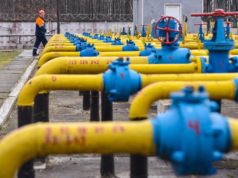Many Americans perceive the fight for energy security and the effort to reduce our oil dependence as synonymous with the effort to curb greenhouse gas emissions. Politicians talking about energy often bind together energy security and the environment, creating the impression that using less oil would not only slow down the transfer of wealth to oil-exporting regimes, but also the melting of the icecaps.
To some degree this is true. Many components of energy policy, like increased fuel efficiency, the use of mass transit, the shift to some renewable fuels, and the electrification of transportation, can offer both security and environmental benefits. If a car uses less gasoline, fewer dollars migrate abroad, and fewer tons of carbon dioxide release into the atmosphere.
Greens and hawks have much to agree on in pursuing their respective goals. But these two constituencies are not as aligned as many tend to think. Energy security and greenhouse gas reduction are not complementary issues. Many of the technologies and policies that could assist one could well be an impediment to the other.
Mapping the Interests
Let’s begin with environmentalists. In the short history of the 21st century, no issue has risen from near obscurity to the center of our public discourse as quickly as global warming. What started as chatter among some concerned scientists and diehard environmentalists is now called “the challenge of our generation,” consuming a bandwidth equivalent of war among world leaders.
For environmentalists, the enemy is carbon. They measure every source of energy by its carbon content, and every human activity by its carbon footprint. Accordingly, carbon-emitting fossil fuels like coal, oil, and natural gas are viewed with scorn.
On the other side, there are the security hawks. As they see it, green may be the color of environmentalism, but it is also the color of the flag of the Islamists who wish us dead. They also note that green is the color of our currency, the dollar, which is in grave danger as a result of our economic decline, the mounting national debt, and our growing trade deficit, largely caused by our thirst for oil imports.
These concerns have lured conservatives, evangelical Christians, veterans, and Jews into the energy debate. For them, national security and economic security are a higher priority than global warming. They see the energy challenge in the context of the war on radical Islam. We are dependent on those who wish us ill, and who are using our petrodollars against us. Indeed, more than three-quarters of the world’s oil reserves are in countries where radical Islam is on the rise.
Hawks are traditionally interested in reforming the transportation sector, 95 percent of which is powered by petroleum. By contrast, environmentalists are concerned with a broader set of issues, including electricity generation and transmission. However, contrary to popular thinking, America hardly generates any electricity from oil. Indeed, much has changed since the 1970s, when we generated a significant percentage of our electricity from oil, which made conserving electricity tantamount to saving oil. Today only 2 percent of our power is generated from oil.
Thus, despite claims that nuclear energy, solar, and wind power can reduce oil use, such sources of energy are irrelevant to breaking our oil dependence. If we build more nuclear reactors, solar panels, or wind farms, we might displace coal or natural gas. However, there will be virtually no oil displacement.
Between Energy & Environment
Perhaps the biggest bone of contention between greens and conservatives in the U.S. has to do with the utilization of domestic energy resources. Hawks seek to tap energy resources in the U.S. in order to reduce our reliance on foreign sources. Greens are steadfastly opposed.
According to the U.S. Department of Interior, there are 21 billion barrels of conventional crude oil and 187 trillion cubic feet of natural gas below federally-controlled lands, mostly in the Western U.S. and in Alaska. An additional 85 billion barrels are believed to lie offshore, in the Outer Continental Shelf of the U.S. (To put these figures in perspective, U.S. annual oil consumption in 2007 stood at 7.5 billion barrels and its natural gas consumption stood at 23 trillion cubic feet.) However, environmental opposition has put these resources mostly out of reach.
Similarly, environmental opposition has blocked non-conventional sources of crude. With 25 percent of the world’s coal reserves, the U.S. could deploy coal-to-liquids technology, which would be profitable as long as crude oil remains above $60 a barrel. But, for environmentalists, using coal to displace oil is a nightmare scenario. Indeed, coal-derived fuel produces twice as much CO2 per unit as petroleum-based fuel.
Other non-conventional oils like oil shale and Canadian tar sands are equally problematic for greens.
Biofuels also pose a challenge to many environmentalists. Rising global demand for biofuels has caused Indonesia, where palm-oil plantations are grown for biodiesel production, to clear land for new crops, thereby removing CO2-soaking forests. This now makes Indonesia the world’s third largest emitter, after the U.S. and China.
Broadly speaking, many environmentalists who in the past strongly supported biofuels now oppose them because of the unintended consequences of the sudden growth of the industry, which they view as unsustainable. Security hawks, by contrast, see biofuels as an immediate and imperative oil displacement strategy.
If there is an inconvenient truth, it may be that we are thus far unable to address the concerns of both camps simultaneously.
A Tale of Two Presidents
During the eight years of the George W. Bush Administration, the U.S. faced constant reminders of its energy security challenge. This included geopolitical tensions with oil exporters, hurricanes in the Gulf of Mexico, the rise of China, and a seven-fold increase in the price of crude oil. Accordingly, energy security assumed a far higher priority than global warming; Bush pushed for increased domestic oil production, investment in the development of shale oil, and a streamlined refinery permitting process.
Since stating in his State of the Union address that, “America is addicted to oil,” Bush became increasingly open to policies anathema to many conservatives. The Energy Independence and Security Act of 2007 raised the Corporate Average Fuel Economy (CAFE) standard for the first time since 1978, setting a target of 35 miles per gallon (mpg) for cars and light trucks by 2020. The law also set a mandatory Renewable Fuel Standard (RFS), requiring fuel producers to use at least 36 billion gallons of biofuels (mostly made from non-food crops) in 2022—nearly five times the current levels.
While these policies sat well with environmentalists, the Bush Administration’s overall indifference to global warming and its rejection of international pressure to adopt restrictions on greenhouse gas emissions infuriated the movement.
The Barack Obama Administration and the Democrat-controlled 111th Congress have since made sweeping changes. Even before entering the White House, President Obama declared his commitment to take aggressive measures to reduce carbon dioxide emissions by 80 percent by 2050, and to sign up America for a post-Kyoto international regime to combat global warming.
Obama also pledged to end America’s oil dependence. As the Democratic presidential nominee, he said: “I will set a clear goal as president: In 10 years we will finally end our dependence on oil in the Middle East.” Once elected, he implemented oil policies that are in sync with environmental principles. The most significant was his increase in fuel efficiency standards. In May 2009, he announced new CAFE standards of 35.5 mpg by 2016.
When faced with tradeoffs between security and the environment, Obama has been more green than hawk. His Environmental Protection Agency, for example, seeks to penalize farmers for cutting down trees or switching crops to grow corn for ethanol. The policy is clear: Regardless of how many petrodollars it diverts from dangerous regimes, ethanol is only acceptable as an alternative fuel if its carbon footprint is low.
The first energy legislation passed by the House of Representatives during the Obama Administration, the American Clean Energy and Security Act of 2009 (also known as the Waxman-Markey cap-and-trade bill), takes ambitious measures to reduce greenhouse gas emissions. However, despite claims that the bill will reduce America’s oil dependence, the legislation would do little in that regard. In fact, by penalizing coal more harshly than oil due to its higher carbon content, the bill might actually increase oil use for electricity generation.
Global warming also appears to trump security in Obama’s foreign policy. Consider the case of India, where growing demand for electricity poses a dilemma. As the owner of 10 percent of the world’s coal reserves, India could provide for most of its own power needs. However, environmentalists warn that coal power for one billion Indians means a lot of CO2. By contrast, security-minded people are more concerned about India shifting to the cleaner alternative, natural gas. Should India decide to power its turbines with natural gas, it is likely to become increasingly dependent on neighboring Iran, the world’s second largest natural gas reserve.
In May 2009, Iran and Pakistan signed a deal to connect their economies via a 1,300-mile natural gas pipeline. Iran is eager to extend the pipeline to India. Access to the Indian subcontinent means an economic lifeline, particularly at a time when the U.S. is trying to weaken it economically with sanctions. The Bush Administration was vocally opposed to the pipeline project, and offered India civilian nuclear assistance as a way to scale up electricity production. The Obama Administration, by contrast, has been mute on the issue. Instead, it has pressured India to give more consideration to global warming.
In a July 2009 visit in India, Secretary of State Hillary Clinton urged New Delhi to accept binding limits on carbon emissions. The Indian people, on a per capita basis, have among the world’s lowest emissions. They flatly rejected Clinton’s proposal. But continuous pressure by the Obama Administration to reduce its emissions could bring India to change course and deal directly with Iran.
Squaring Security & Environmental Concerns
What can greens and hawks agree on?
First, both must recognize that in order to address any of their goals, we must first prosper. If there is any hope for significant greenhouse gas reduction, it comes from wealthy industrial countries. The salvation certainly won’t come from developing countries like China and India, where environmental concerns are a distant second to basic human needs—access to electricity, food, and shelter.
Therefore, curbing greenhouse gas emissions would be contingent on the prosperity and economic resilience of America and other developed nations. A weakened, economically depleted America doesn’t bode well for the climate movement. Conversely, prosperity is difficult to achieve, as long as our economy hemorrhages money to purchase foreign oil.
Second, both greens and hawks must recognize that oil’s strategic status derives not from the amount of oil we import or consume, but from its virtual monopoly over transportation fuel. As long as the vast majority of our cars and trucks can run on nothing but oil, alternatives to oil will be shut out of the transportation fuel market and we will forever be beholden to rogue states.
The key to both energy security and reduced carbon emissions is therefore in vehicle platforms that enable fuel competition. Existing technology, in the form of flexible fuel vehicles, is the answer. New cars sold in the U.S. that are equipped with an internal combustion engine should allow for fuel competition by being flexible fuel vehicles. Similarly, new diesel cars should be capable of operating on biodiesel. Such an open fuel standard would help to protect the U.S. economy from high and volatile oil prices and from the threats caused by global instability, while enabling market penetration of alternative fuels that are less carbon intensive.
And because electricity is 98 percent petroleum-free, greens and hawks can also work together to speed up the commercialization of electric cars and plug-in hybrids. This, too, would satisfy the concerns of the environmental movement, while bolstering national security.
In the end, greens and hawks must focus on a unified agenda. Without identifying commonalities, both will continue to undercut each other, leaving America exposed.
Gal Luft ifs Executive Director of the Institute for the Analysis of Global Security (IAGS) and co-founder of the Set America Free Coalition. He is co-author of Energy Security Challenges in the 21st Century (Praeger 2009) and Turning Oil into Salt: Energy Independence Through Fuel Choice (Amalfi Press, 2009).





